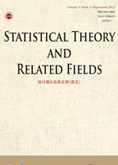References
- Bertsekas, D. P. (1999). Nonlinear programming. Belmont, MA: Athena Scientific. [Google Scholar]
- Bunea, F. (2004). Consistent covariate selection and post model selection inference in semiparametric regression. The Annals of Statistics, 32, 898–927. [Google Scholar]
- Chen, J. H., & Chen, Z. H. (2008). Extended Bayesian information criterion for model selection with large model spaces. Biometrika, 95, 759–771. [Google Scholar]
- Cheng, M. Y., Honda, T., & Zhang, J. T. (2016). Forward variable selection for sparse ultra-high dimensional varying coefficient models. Journal of the American Statistical Association, 111, 1209–1221. [Taylor & Francis Online], [Google Scholar]
- Cui, H. J., Li, R. Z., & Zhong, W. (2015). Model-free feature screening for ultra-high dimensional discriminant analysis. Journal of the American Statistical Association, 110, 630–641. [Taylor & Francis Online], [Google Scholar]
- Efron, B., Hastie, T., Johnstone, I., & Tibshirani, R. (2004). Least angle regression. The Annals of Statistics, 32, 407–499. [Google Scholar]
- Fan, J. Q., Feng, Y., & Song, R. (2011). Nonparametric independence screening in sparse ultra-high dimensional additive models. Journal of the American Statistical Association, 106, 544–557. [Taylor & Francis Online], [Google Scholar]
- Fan, J. Q., & Gijbels, I. (1996). Local polynomial modeling and its applications. London: Chapman and Hall. [Google Scholar]
- Fan, J. Q., & Lv, J. C. (2008). Sure independence screening for ultra-high dimensional feature space (with discussion). Journal of the Royal Statistical Society, Series B, 70, 849–911. [Google Scholar]
- Fan, J. Q., Ma, Y. B., & Dai, W. (2014). Nonparametric independence screening in sparse ultra-high-dimensional varying coefficient models. Journal of the American Statistical Association, 109, 1270–1284. [Taylor & Francis Online], [Google Scholar]
- Härdle, W., Liang, H., & Gao, J. T. (2000). Partially linear models. Heidelberg: Springer Physica. [Google Scholar]
- Knight, W. A., Livingston, R. B., Gregory, E. J., & McGuire, W. L. (1977). Estrogen receptor as an independent prognostic factor for early recurrence in breast cancer. Cancer Research, 37, 4669–4671. [Google Scholar]
- Li, Y. J., Li, G. R., Lian, H., & Tong, T. J. (2017). Profile forward regression screening for ultra-high dimensional semiparametric varying coefficient partially linear models. Journal of Multivariate Analysis, 155, 133–150. [Google Scholar]
- Li, G. R., Peng, H., Zhang, J., & Zhu, L. X. (2012). Robust rank correlation based screening. The Annals of Statistics, 40, 1846–1877. [Google Scholar]
- Li, G. R., Zhang, J., & Feng, S. Y. (2016). Modern measurement error models. Beijing: Science Press. [Google Scholar]
- Li, R. Z., Zhong, W., & Zhu, L. P. (2012). Feature screening via distance correlation learning. Journal of the American Statistical Association, 107, 1129–1139. [Taylor & Francis Online], [Google Scholar]
- Liang, H., & Li, R. Z. (2009). Variable selection for partially linear models with measurement errors. Journal of the American Statistical Association, 104, 234–248. [Taylor & Francis Online], [Google Scholar]
- Liang, H., Wang, H. S., & Tsai, C. L. (2012). Profile forward regression for ultrahigh dimensional variable screening in semiparametric partially linear models. Statistica Sinica, 22, 531–554. [Google Scholar]
- Liu, X., Wang, L., & Liang, H. (2011). Estimation and variable selection for semiparametric additive partial linear models. Statistica Sinica, 21, 1225–1248. [Google Scholar]
- Luo, S. (2012). Feature selection in high-dimensional studies (Doctoral dissertation). National University of Singapore, Singapore. [Google Scholar]
- Luo, S., & Chen, Z. H. (2014). Sequential Lasso cum EBIC for feature selection with ultra-high dimensional feature space. Journal of the American Statistical Association, 109, 1229–1240. [Taylor & Francis Online], [Google Scholar]
- Mammen, E., & van de Geer, S. (1997). Penalized quasi-likelihood estimation in partial linear models. The Annals of Statistics, 25, 1014–1035. [Google Scholar]
- Meinshausen, N., & Bühlmann, P. (2006). High-dimensional graphs and variable selection with the Lasso. The Annals of Statistics, 34, 1436–1462. [Google Scholar]
- Park, M. Y., & Hastie, T. (2007). L1-regularization path algorithm for generalized linear models. Journal of the Royal Statistical Society, Series B, 69, 659–677. [Google Scholar]
- Sherwood, W., & Wang, L. (2016). Partially linear additive quantile regression in ultra-high dimension. The Annals of Statistics, 44, 288–317. [Google Scholar]
- Stewart, B. W., & Wild, C. P. (2014). World cancer report 2014. Lyon: International Agency for Research on Cancer. [Google Scholar]
- Tibshirani, R. (1996). Regression shrinkage and selection via the Lasso. Journal of the Royal Statistical Society, Series B, 58, 267–288. [Crossref], [Google Scholar]
- van't Veer, L. J., Dai, H. Y., van de Vijver, M. J., He, Y. D., Hart, A. A. M., Mao, M., … Friens, S. H. (2002). Gene expression profiling predicts clinical outcome of breast cancer. Nature, 415, 530–536. [Google Scholar]
- Wang, H. S. (2009). Forward regression for ultra-high dimensional variable screening. Journal of the American Statistical Association, 104, 1512–1524. [Taylor & Francis Online], [Google Scholar]
- Wang, L., Liu, X., Liang, H., & Carroll, R. J. (2011). Estimation and variable selection for generalized additive partial linear models. The Annals of Statistics, 39, 1827–1851. [Google Scholar]
- Weisberg, S. (1980). Applied linear regression. New York: Wiley. [Google Scholar]
- Xie, H. L., & Huang, J. (2009). SCAD-penalized regression in high-dimensional partially linear models. The Annals of Statistics, 37, 673–696. [Google Scholar]
- Yu, T., Li, J. L., & Ma, S. G. (2012). Adjusting confounders in ranking biomarkers: A model-based ROC approach. Briefings in Bioinformatics, 13, 513–523. [Google Scholar]
- Zhang, C. H., & Huang, J. (2008). The sparsity and bias of the Lasso selection in high dimensional linear regression. The Annals of Statistics, 37, 1567–1594. [Google Scholar]
- Zhao, P., & Yu, B. (2006). On model selection consistency of Lasso. Journal of Machine Learning Research, 7, 2541–2563. [Google Scholar]
- Zhu, L. P., Li, L. X., Li, R. Z., & Zhu, L. X. (2011). Model-free feature screening for ultrahigh-dimensional data. Journal of the American Statistical Association, 106, 1464–1475. [Taylor & Francis Online], [Google Scholar]
- Zou, H. (2006). The adaptive Lasso and its oracle properties. Journal of the American Statistical Association, 101, 1418–1429. [Taylor & Francis Online], [Google Scholar]














 loading......
loading......